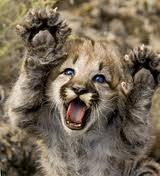Lions and kittens and pharma? Oh my!
Medical Pharmaceutical Translations • Oct 13, 2014 12:00:00 AM

Recently, animal lovers got some good news: shark fin soup is becoming less and less popular in China, with sales dropping 50-70%. According to experts and survey results, while there are other contributing factors, much of the decline is due to awareness campaigns, including one on social media site Sina Weibo, where Chinese celebrities posted photos of themselves covering their mouths.
In addition to concern about a rapidly decreasing shark population, there’s also the cruelty behind the meal: most fishermen cut off a shark’s fin and drop the animal back into the ocean, where, no longer able to swim, it will die a slow, painful death. If the thought of this makes you feel even a twinge of pity, it may be at least partially due to the way (animal) predators are being portrayed in the media and online.
It’s not easy to turn something most people consider scary, into something appealing. But here’s another successful example: in this video, lions come across as overgrown kitties hungry, not for prey, but for affection and attention. These videos do the same for some of their cousins, who caretakers at wildlife sanctuary Big Cat Rescue recently filmed acting more like our pet cats than kings of the jungle.
And then there’s the more scientific approach. Take the wolves of Yellowstone Park, for example. From 1914 to 1926, they were eradicated from the park, in order to protect deer, elk, and bison populations. In the end, it didn’t go so well. By 1995, when the wolves were reintroduced, the park was overgrazed and had less biodiversity than before. In February 2014, “How Wolves Change Rivers”, a video showing the wide-ranging impact of the wolves’ return, was posted by an environmentalist group, and it went viral, getting a million views within just a week (today, about six months later, it has nearly 5 million). Not only is this good news for Yellowstone’s wolves; it’s another way to show the public that predators are a vital part of any ecosystem.
All of this has got me thinking — I mean, beyond just being really thrilled that these animals are being seen in a different light, and the way that this is helping them survive. If you think about it, the medical world faces similar issues. Although the general public might understand the importance or usefulness of some treatments, procedures, and care options, they might also find them nerve-wracking, counter-intuitive, or even downright terrifying. What would happen if the medical and pharmaceutical industries used similar techniques as those used to improve predators’ images? I’d like to throw down a challenge to anyone willing and able to take it up: try to change the way the world looks at one of these healthcare “bad guys” – and make your ads go viral:
– dental appointments
– vaccines (not necessarily for anti-vaxxers; lots of people are just scared of needles)
– mammograms
– colonoscopies
– any other type of screening for a disease or condition
– anesthesia
– Ebola prevention and detection in countries where this is currently an issue
There are many more, of course. I’m hoping that one day I’ll see at least one of them portrayed in a new way – and not just because I’d really like not to feel so scared when my doctor tells me I need a Tetanus booster; like re-marketing apex predators, marketing these issues differently could end up saving lives.
